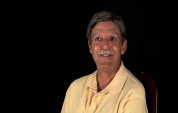4:50 | The M-16 made every Army rifleman an automatic rifleman, explains Dennis Haines, who gave his up to become the M-60 gunner in his squad. The M-60 machine gun was the primary heavy weapon on patrols and ambushes.
Keywords : Dennis Haines Vietnam RTO Radio Telephone Operator M-16 M-60 machine gun ammo bearer assistant gunner ammo belt VC Viet Cong muzzle flash M-14 Mattel squad bipod squad leader base camp

Recruit Dennis Haines wanted to go to airborne school but the Army gave him a choice. He could either go to airborne school or home for Christmas. He took the leave because he was worried he might not ever return.
During Advanced Infantry Training, Dennis Haines remembers a problem with the bolt on the M-16 rifle. It would swell and stick. Fortunately, the problem was fixed before the rifles were deployed in the field.
Arriving in Vietnam, Dennis Haines got a quick lesson in weapons safety when a soldier dropped a grenade in practice. He also met Jack Kirchner, who was from the same area at home and the two became great friends.
In his first taste of action in Vietnam, Dennis Haines participated in the clearing of a large bunker complex. Inside, he spotted a Russian pistol just sitting there, begging to be a souvenir.
Dennis Haines was assigned to the 199th Light Infantry Brigade in Vietnam. The only brigade not attached to a division, the light infantry was so-named because they could move out on a mission at a moment’s notice. He describes the execution and fear of a frontal assault.
Dennis Haines and his friend Jack Kirchner came across a Viet Cong bunker that they thought was empty. After Kirchner fired a shotgun round through a port, he turned to leave and was nearly cut in two by enemy rounds.
After the Air Force came in and blew up the VC bunkers, Dennis Haines knew the job was coming that no one wanted to do: the body count.
Dennis Haines had seen dead soldiers on stretchers but it was totally different with his friend Jack Kirchner. Dennis had been right there with him in the line of fire. He learned it was best not to be too close to your wartime comrades.
Fire from an approaching enemy killed Larry Rycroft and wounded Bob Needham and Kenny Pepper. Dennis Haines laments that they could not fire in time because of the Rules of Engagement.
Dennis Haines handed his Instamatic to his friend Tom Reilly so he could get some pictures from the field. This was great until Reilly had to take cover by jumping in a pond.
Dennis Haines had done the reconnaissance on a village at the Mekong River, so he manned the listening post overnight as his unit prepared a cordon operation. He thought he saw movement in a doorway, then a muzzle flash as he took two rounds to the head.
“I was out of it for days,” recalls Dennis Haines, He had a head wound and would only regain full consciousness after he was evacuated to a hospital in Japan, where he learned the left side of his body was paralyzed.
Years after his head wound, Dennis Haines found the surgeon, John Baldwin, who operated on him in the field hospital. Only then did he learn how close to death he had been, so close that he was put in the group of patients who were deemed not likely to survive.
Despite the fact that they could receive no confirmation of his arrival, the family and fiancé of Dennis Haines were there on Christmas Day when he arrived at Walter Reed Hospital. A friendly pilot had made the flight from Alaska fun for the injured warrior.
As if getting shot in the head wasn’t enough, Dennis Haines had many complications on his road to recovery, including a serious infection. He was amused, however, by the process of molding the plastic plate to cover the missing part of his skull.